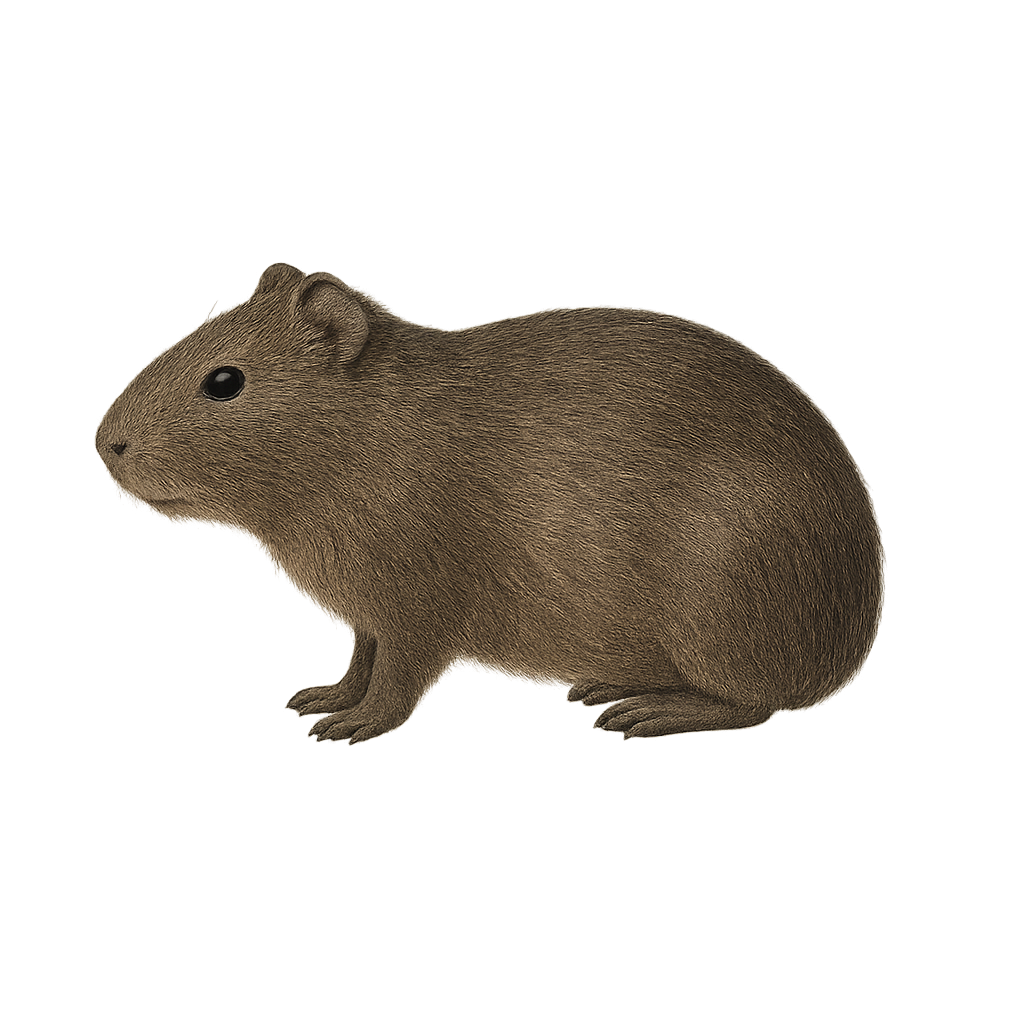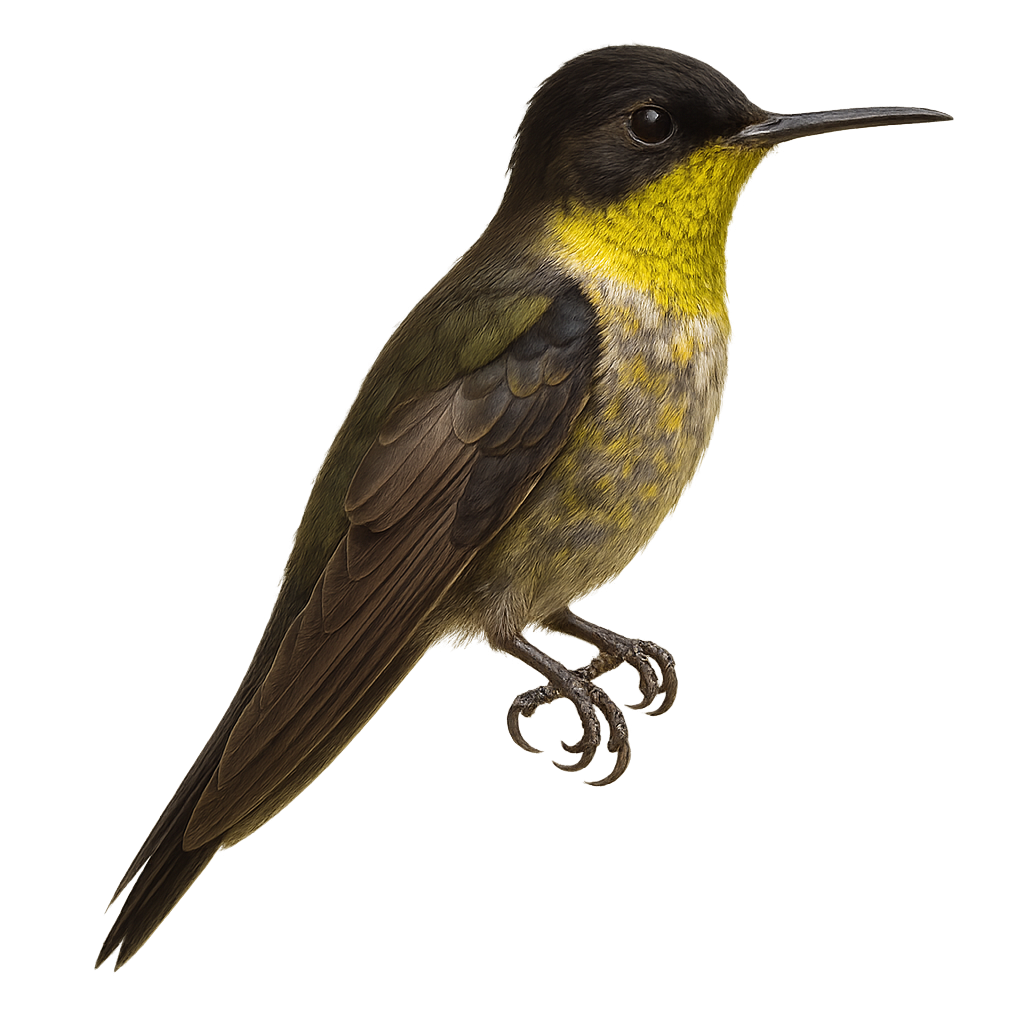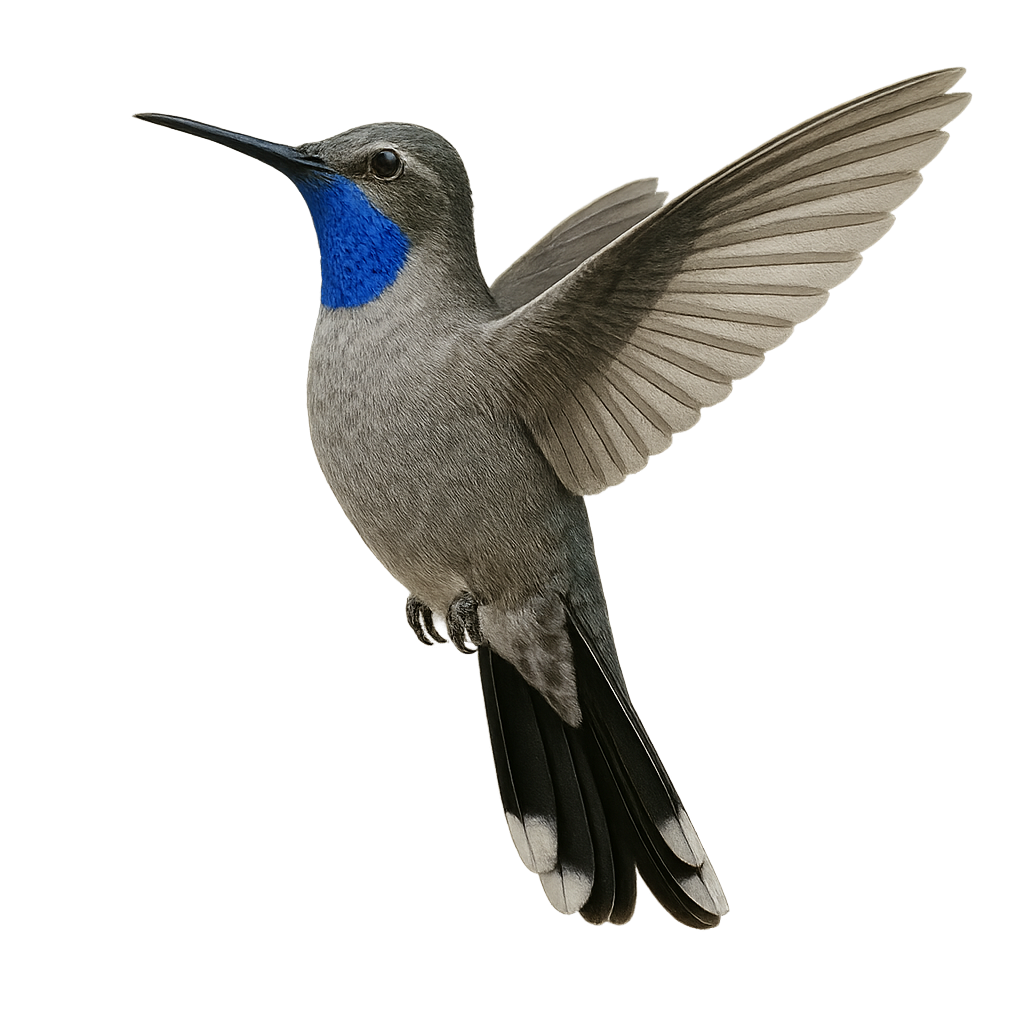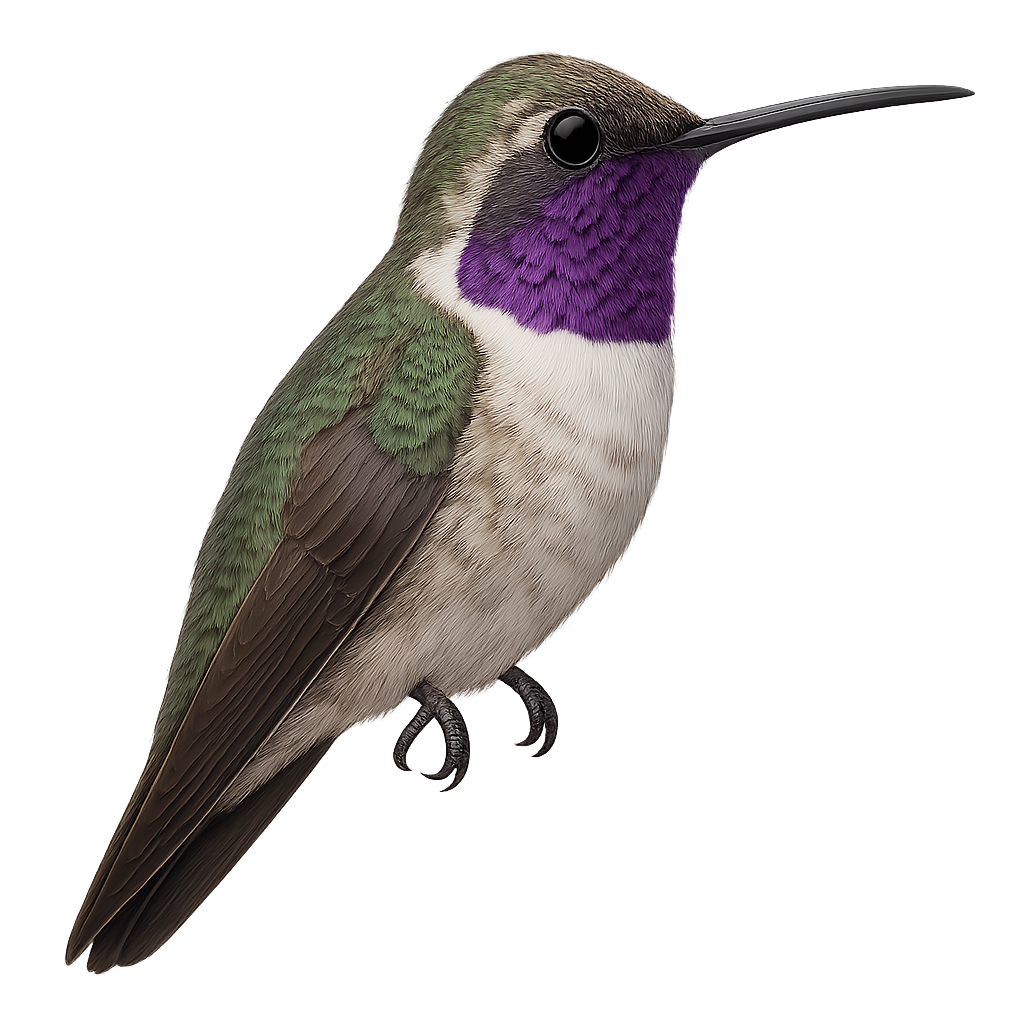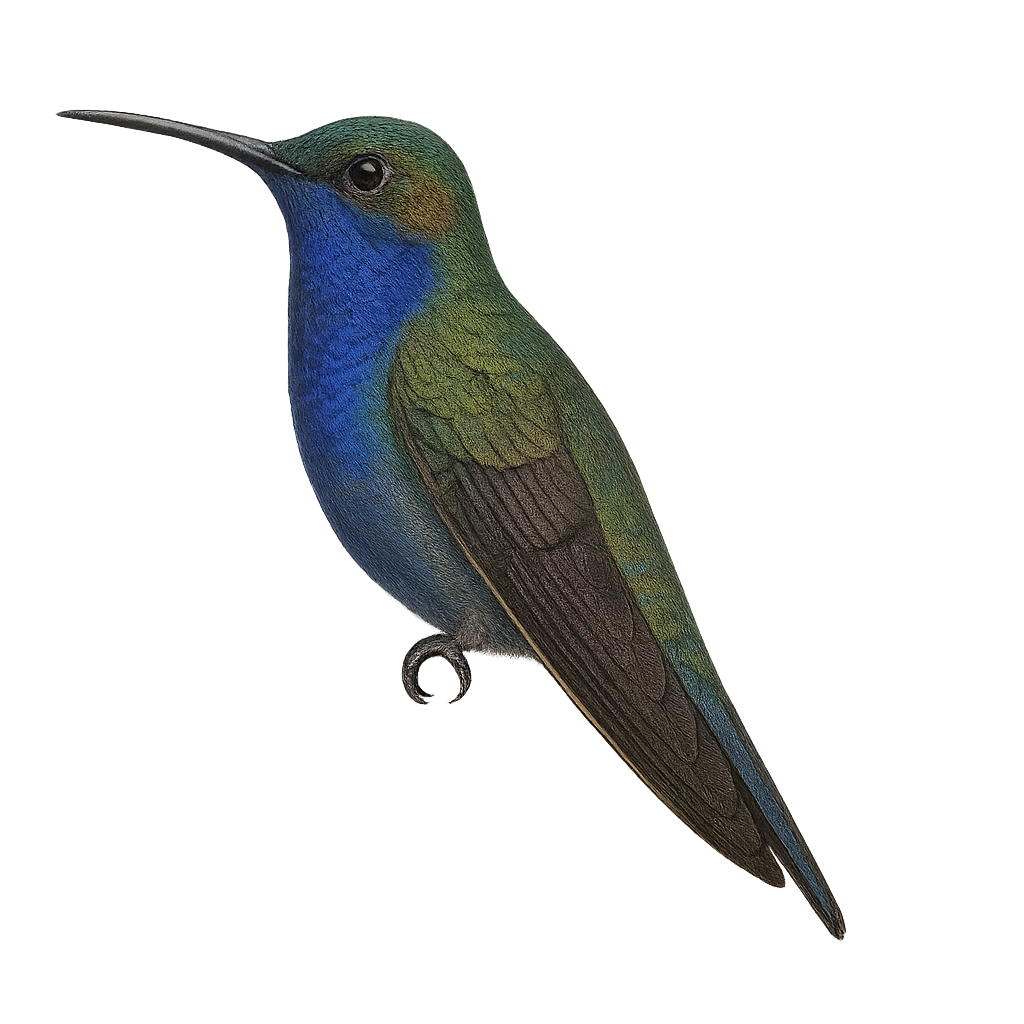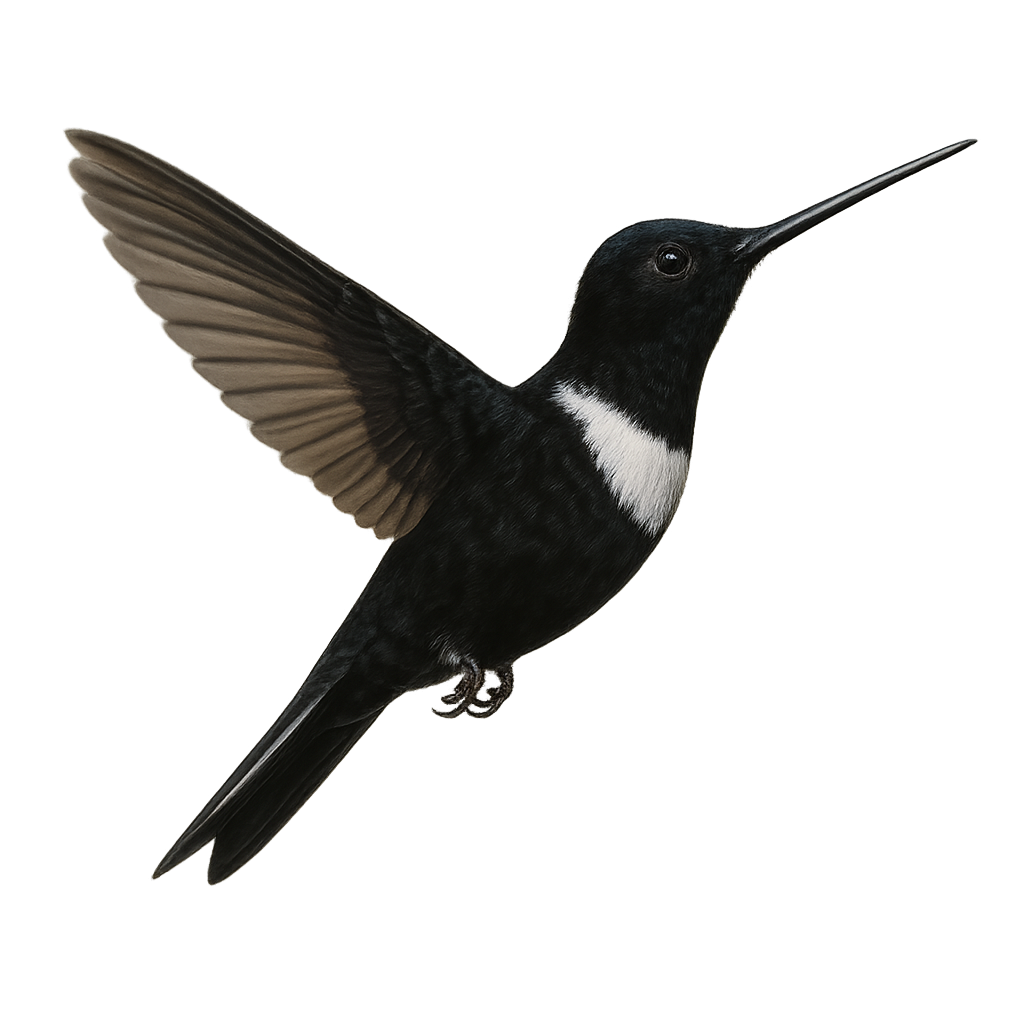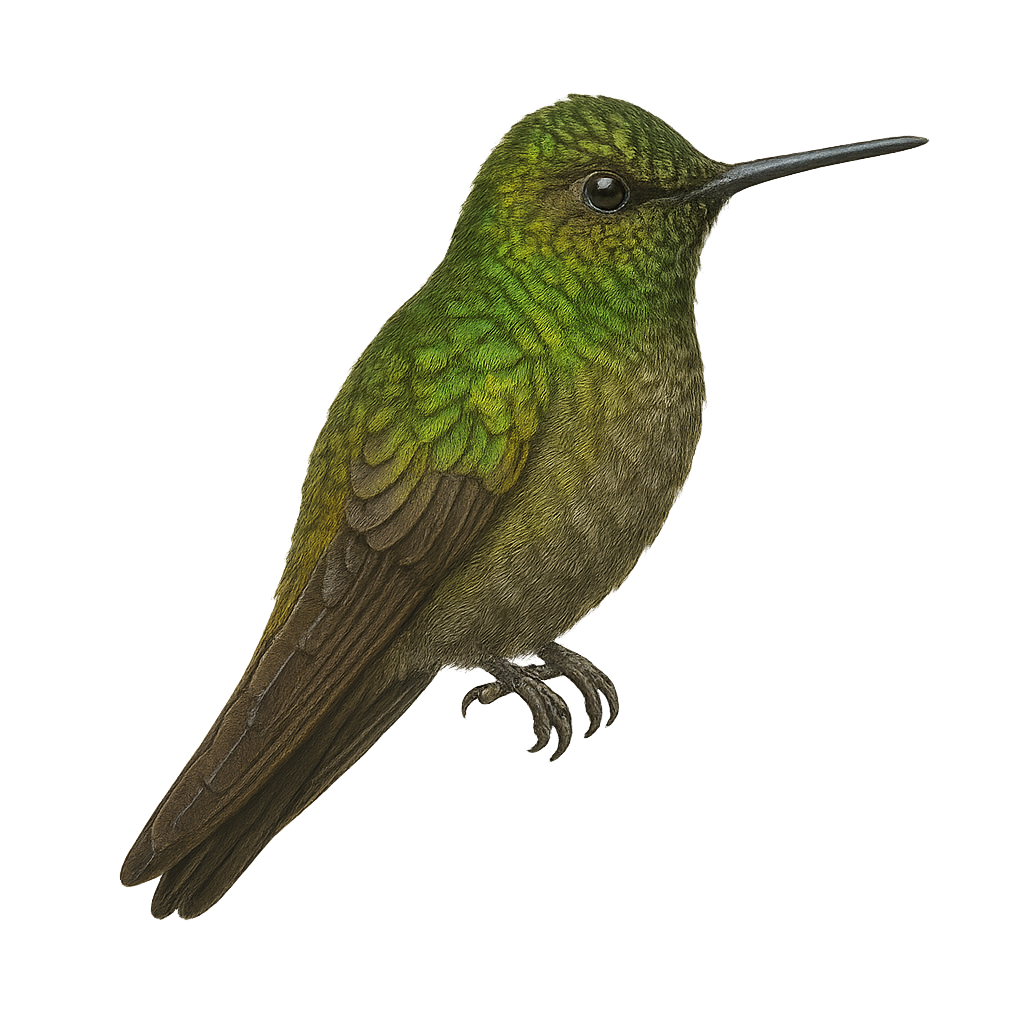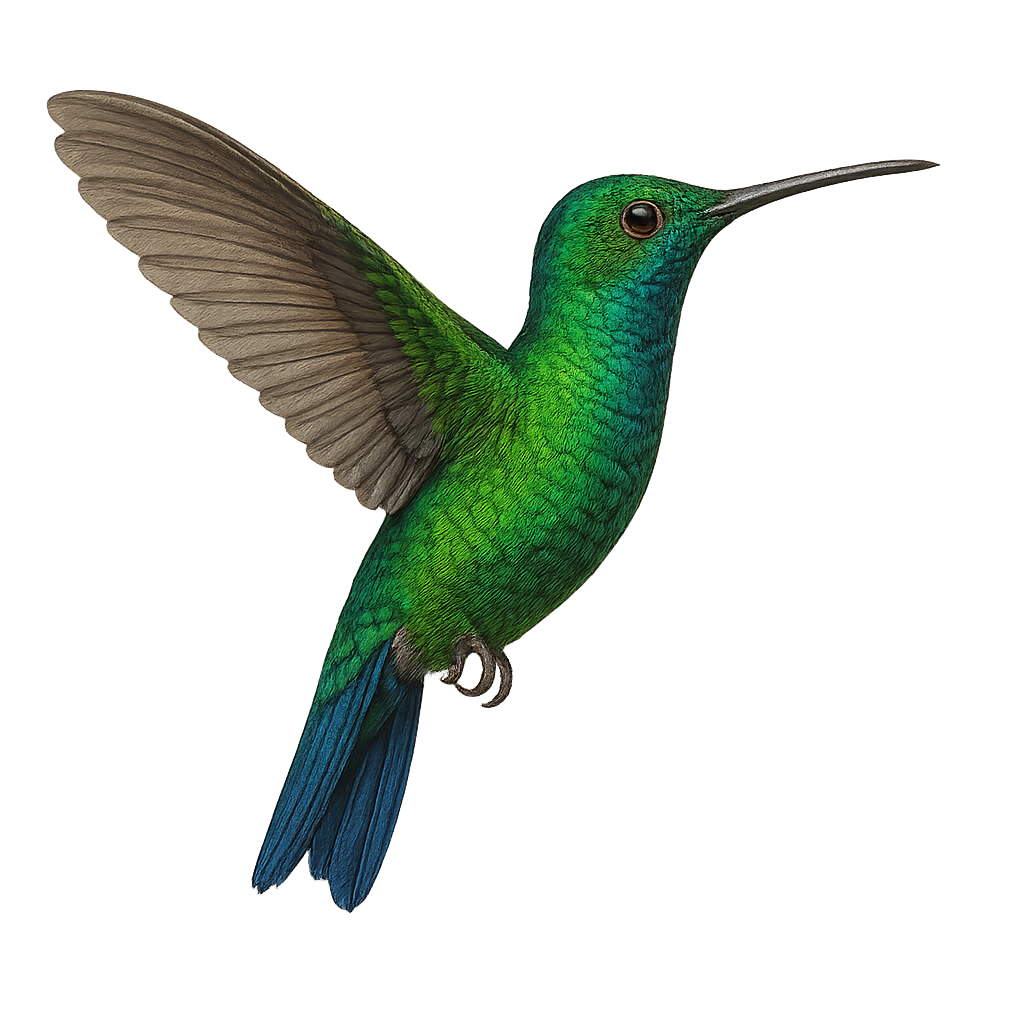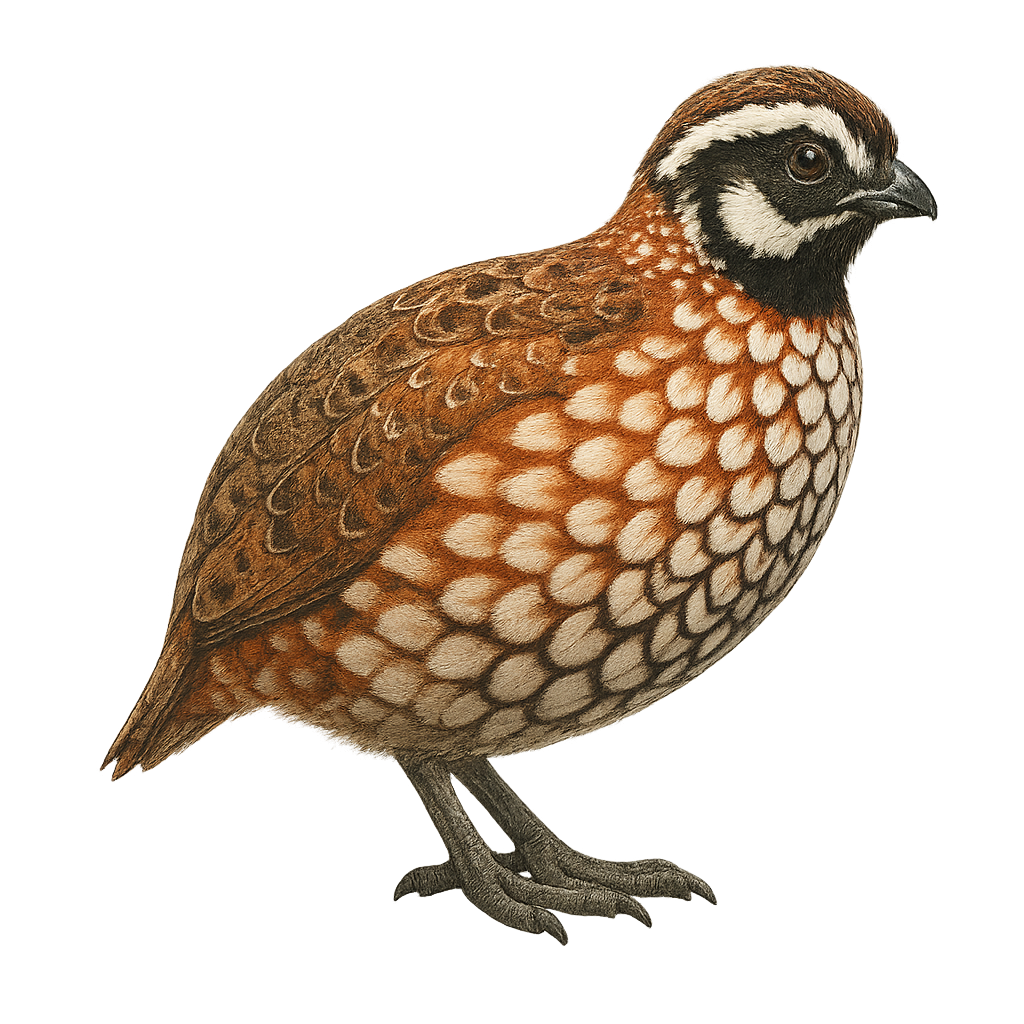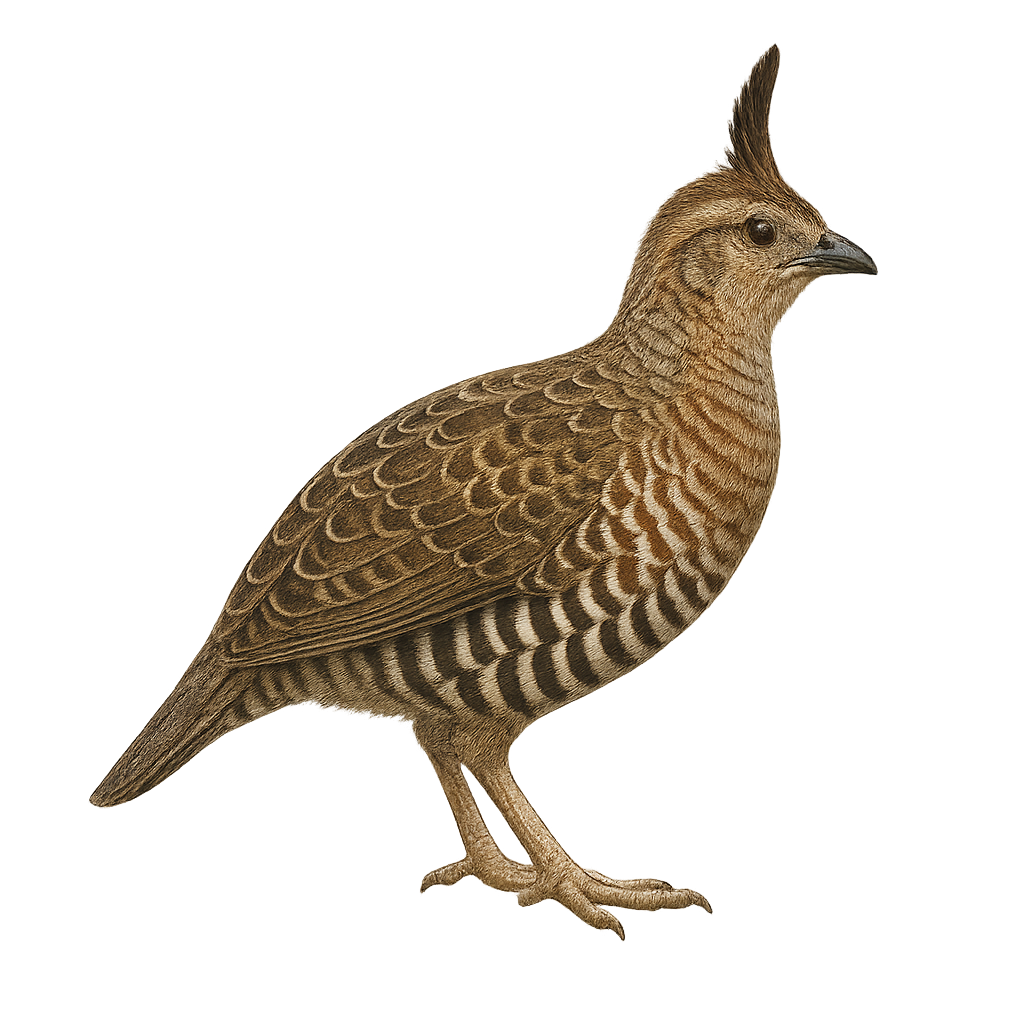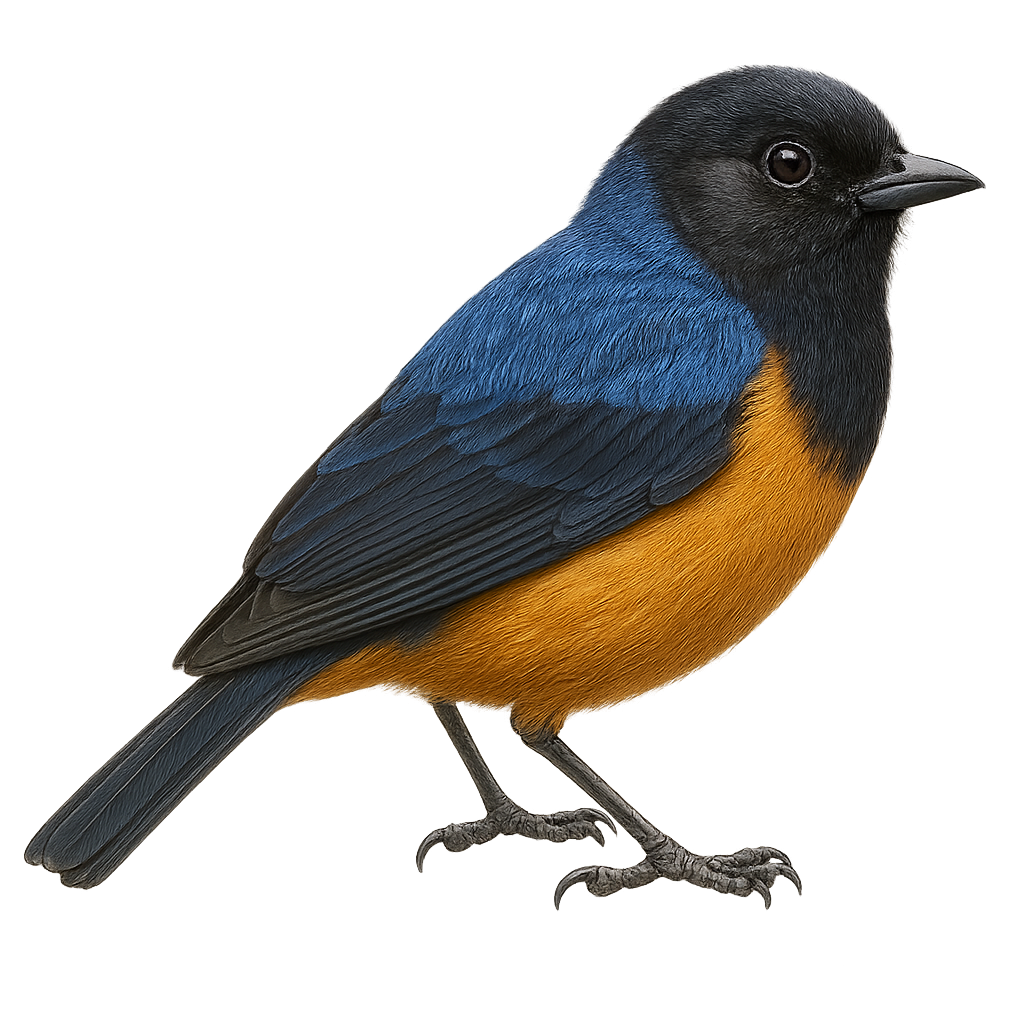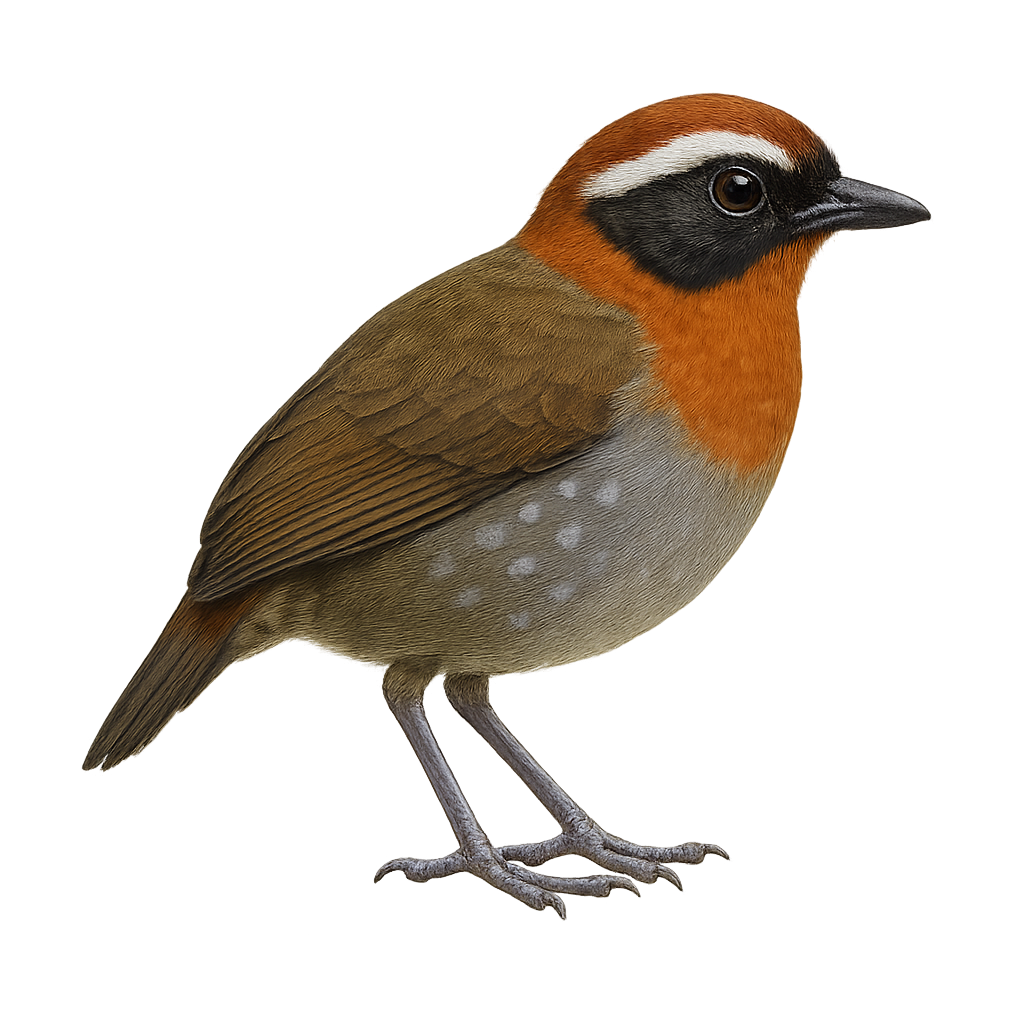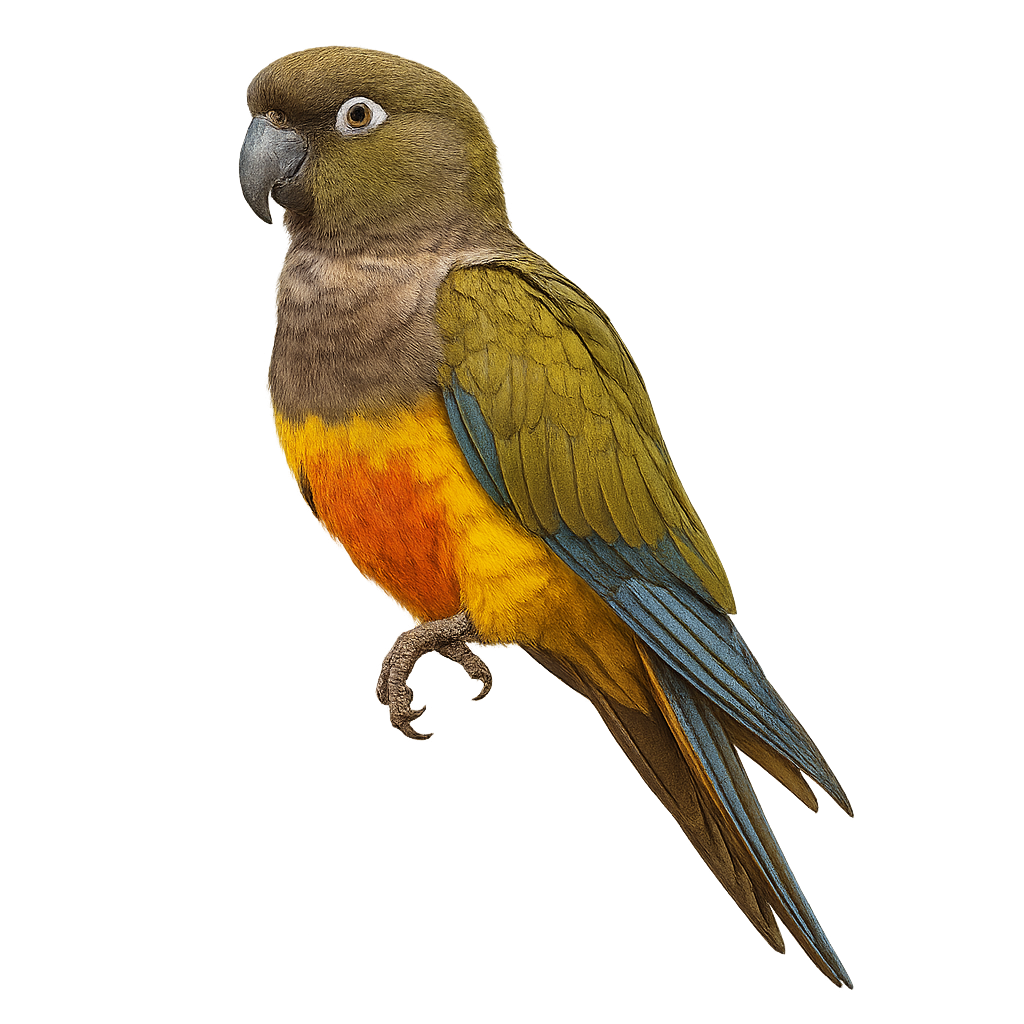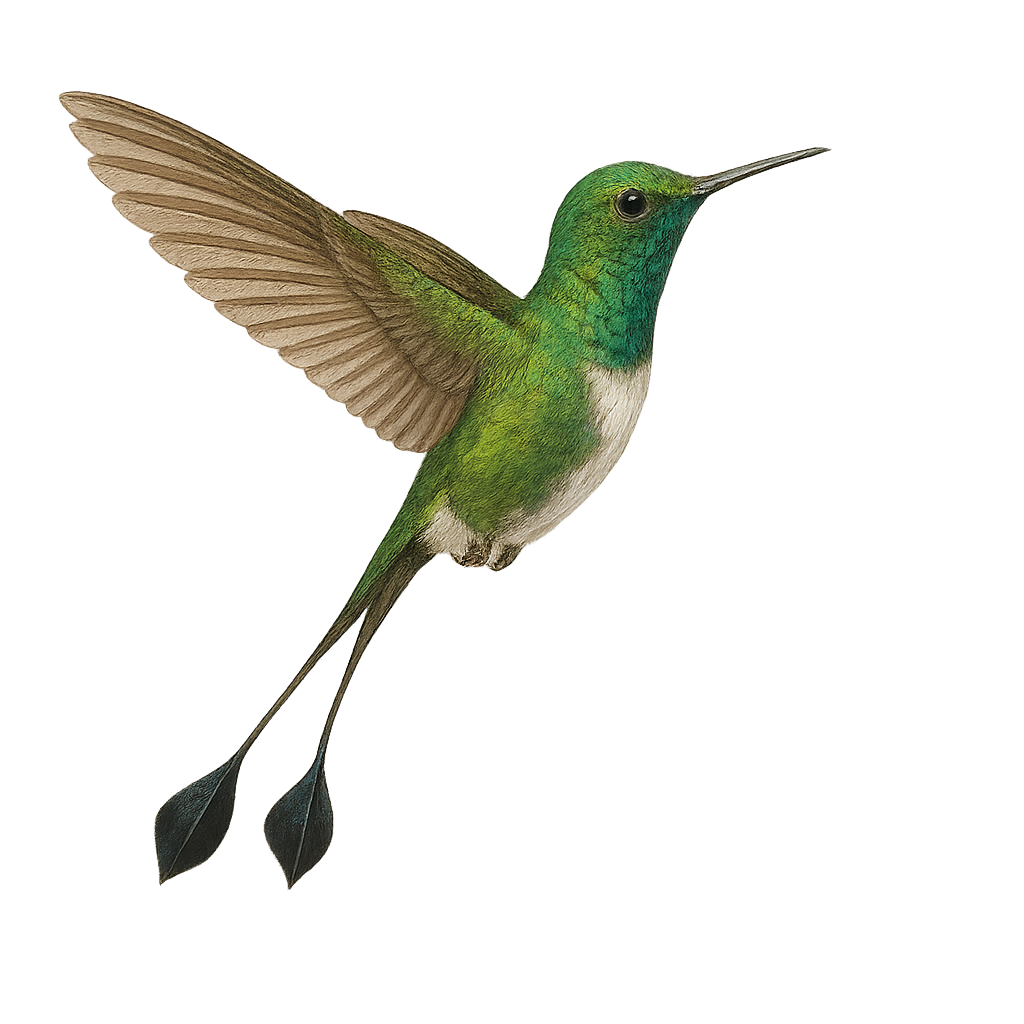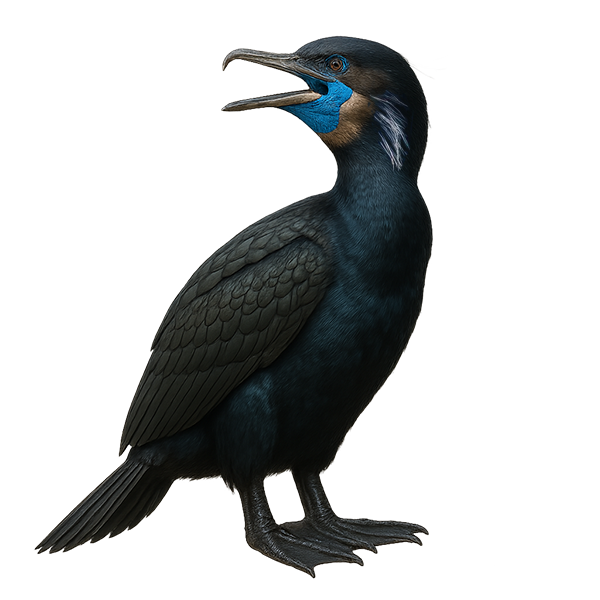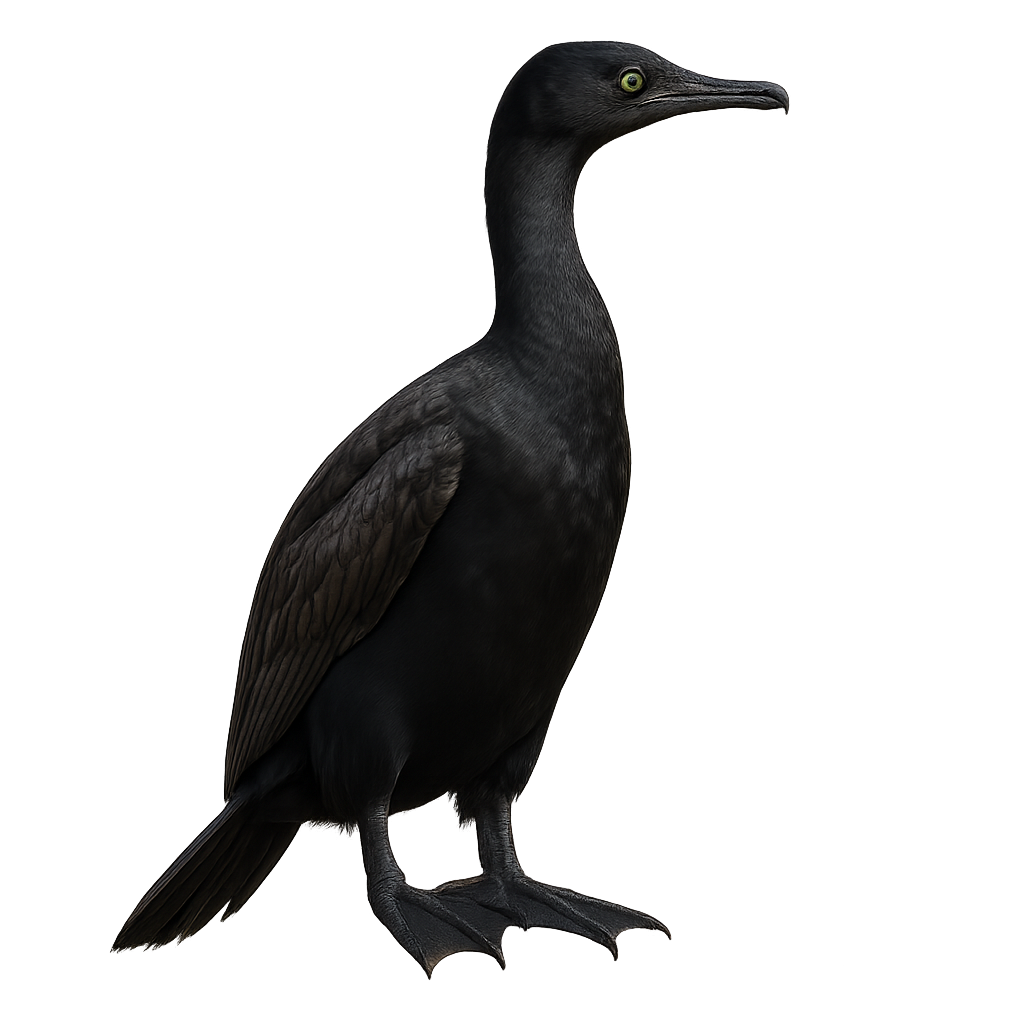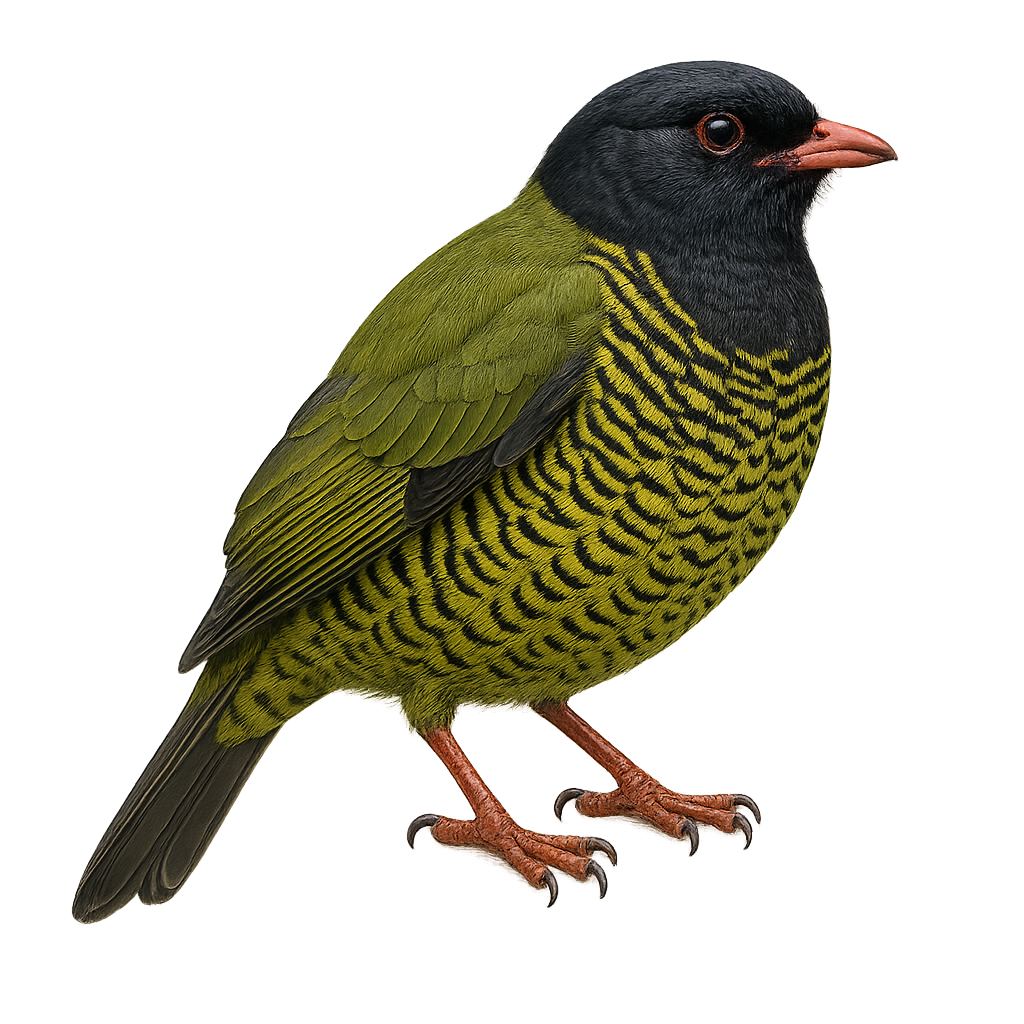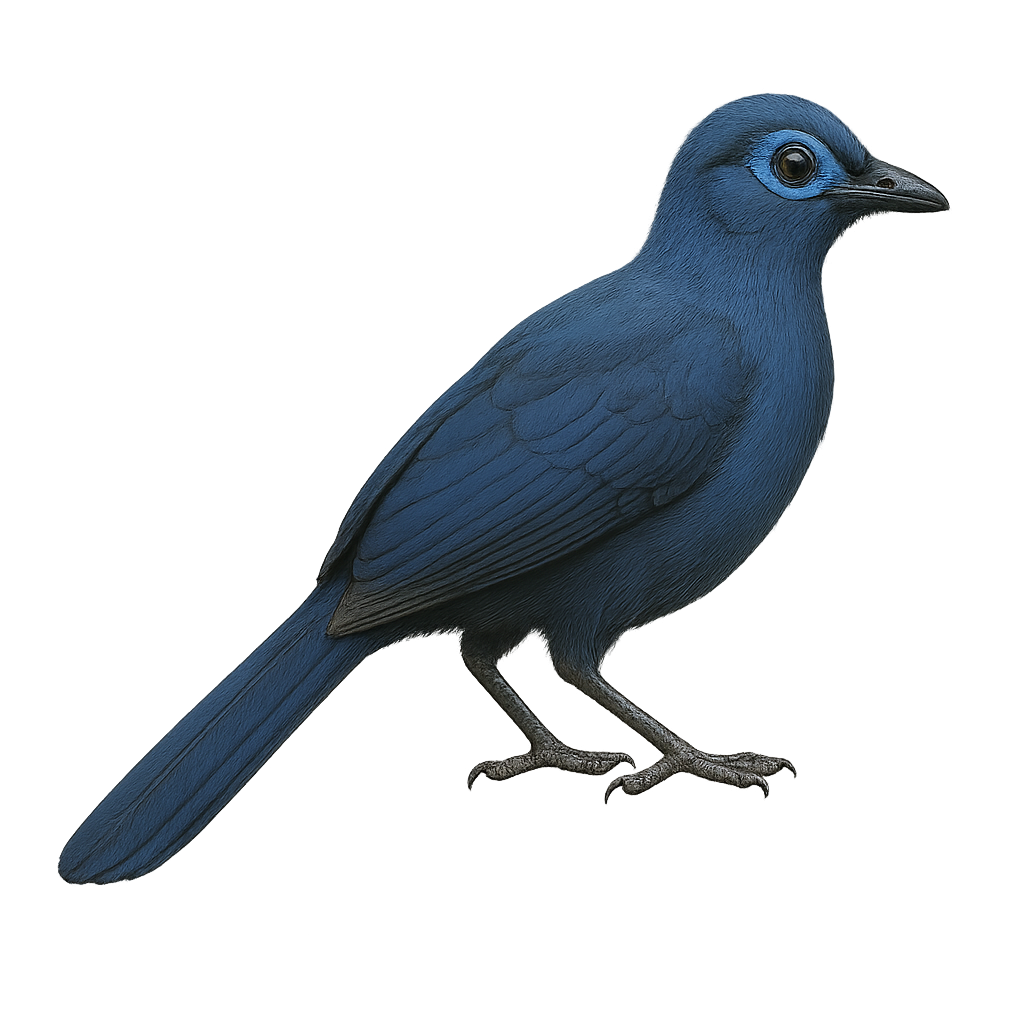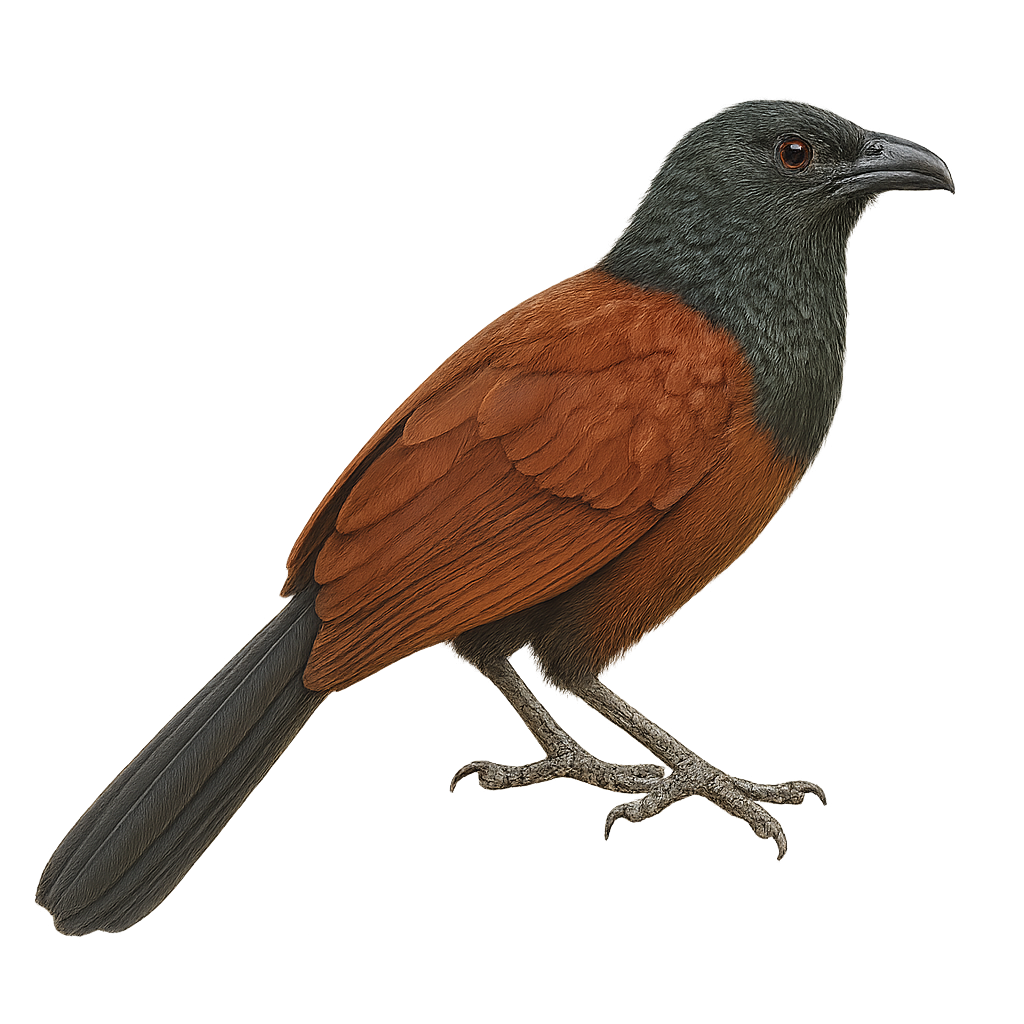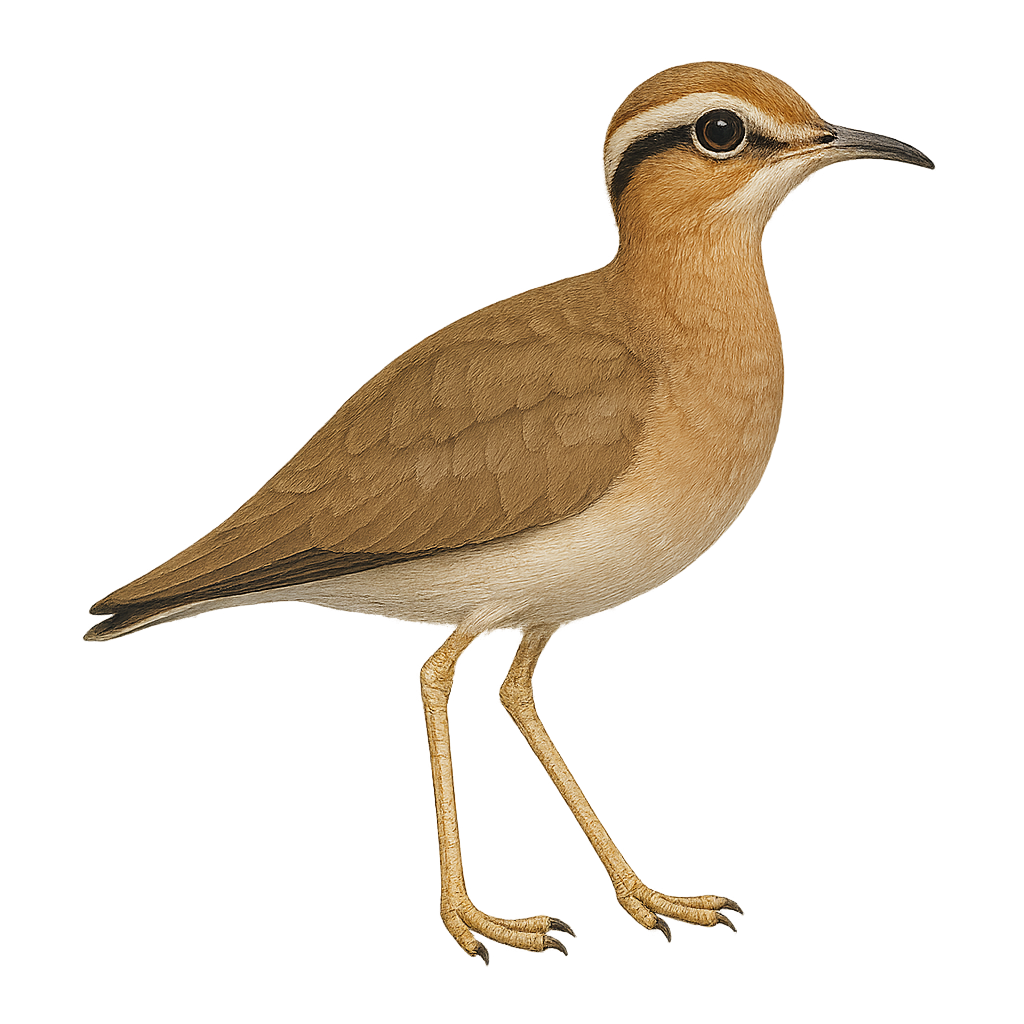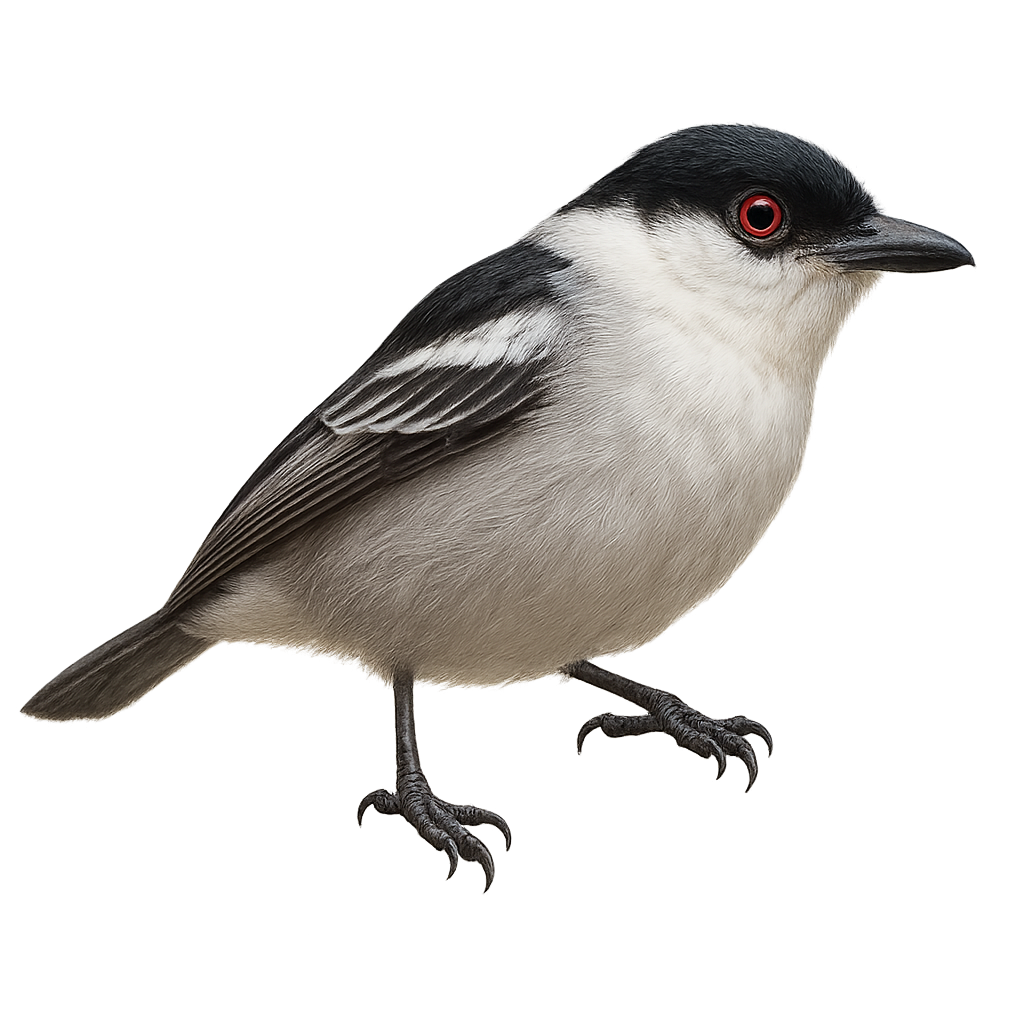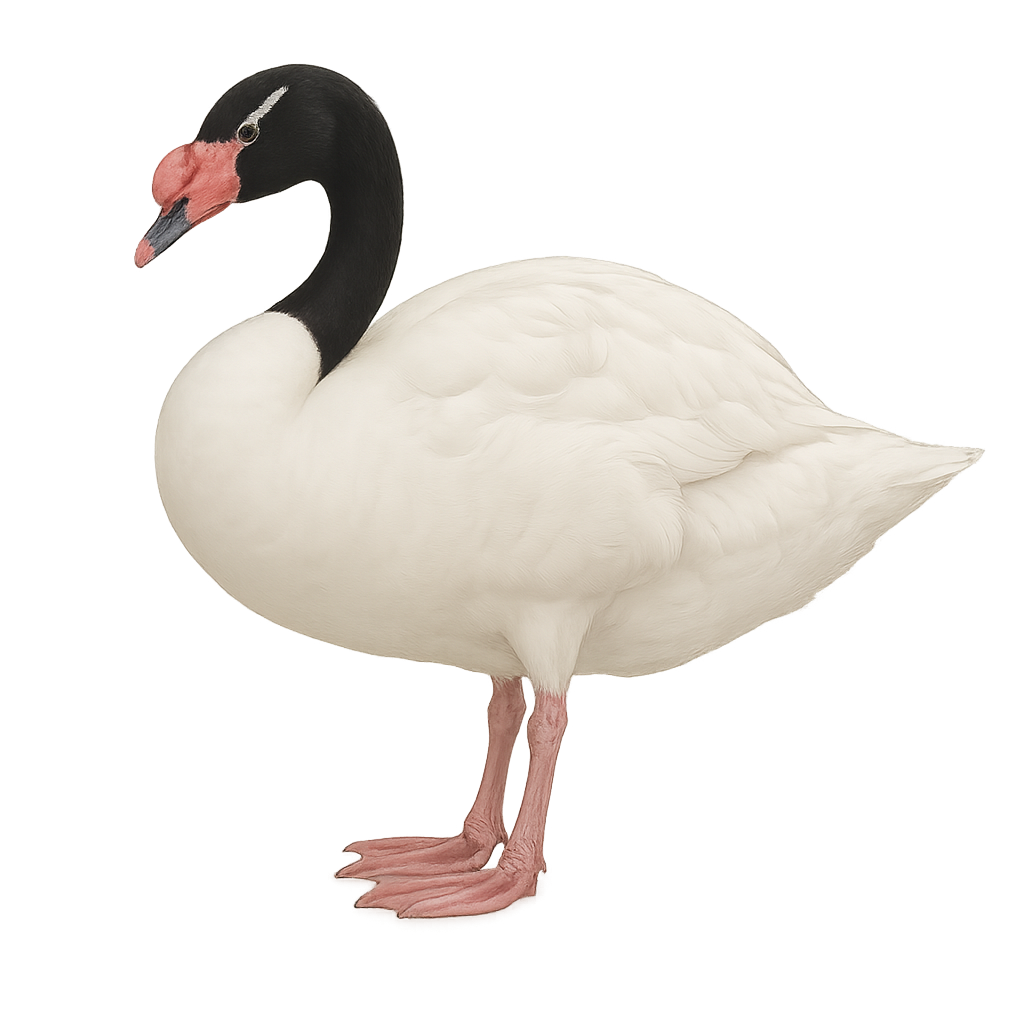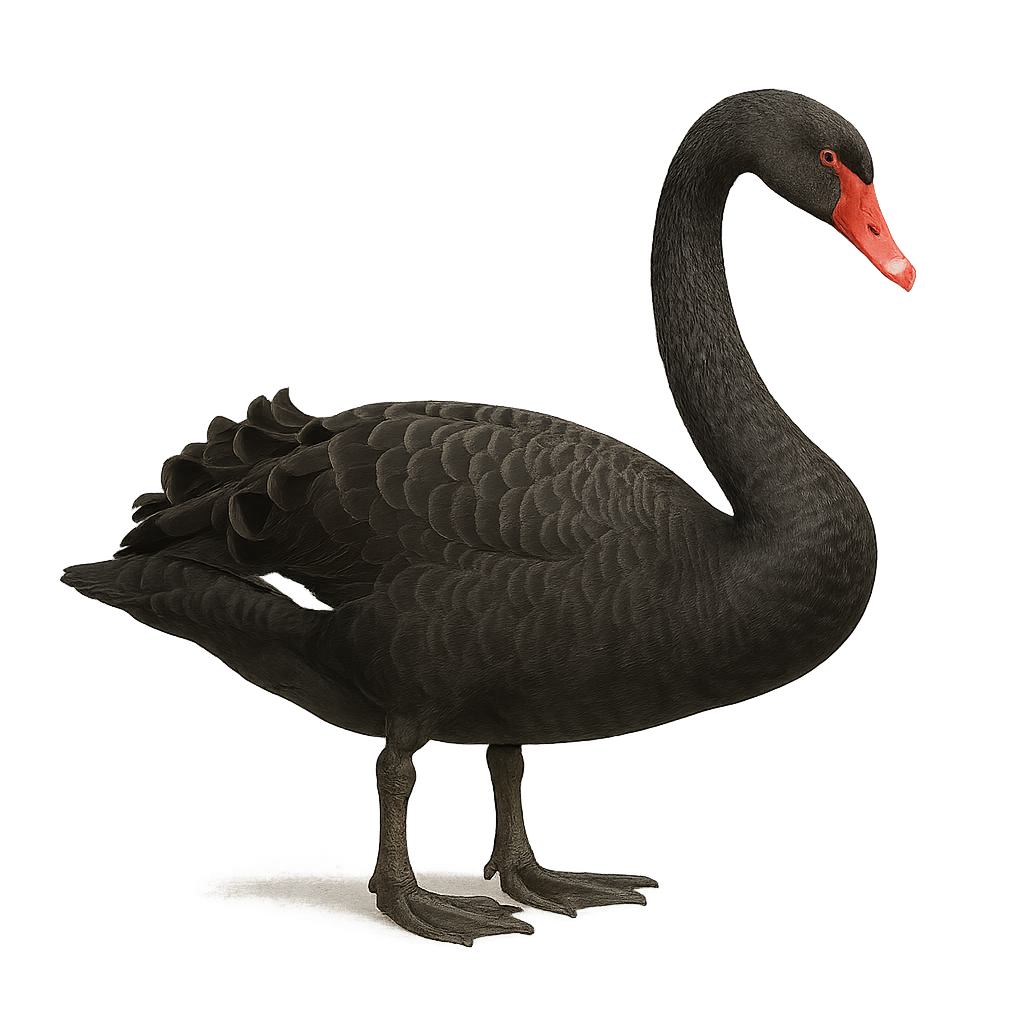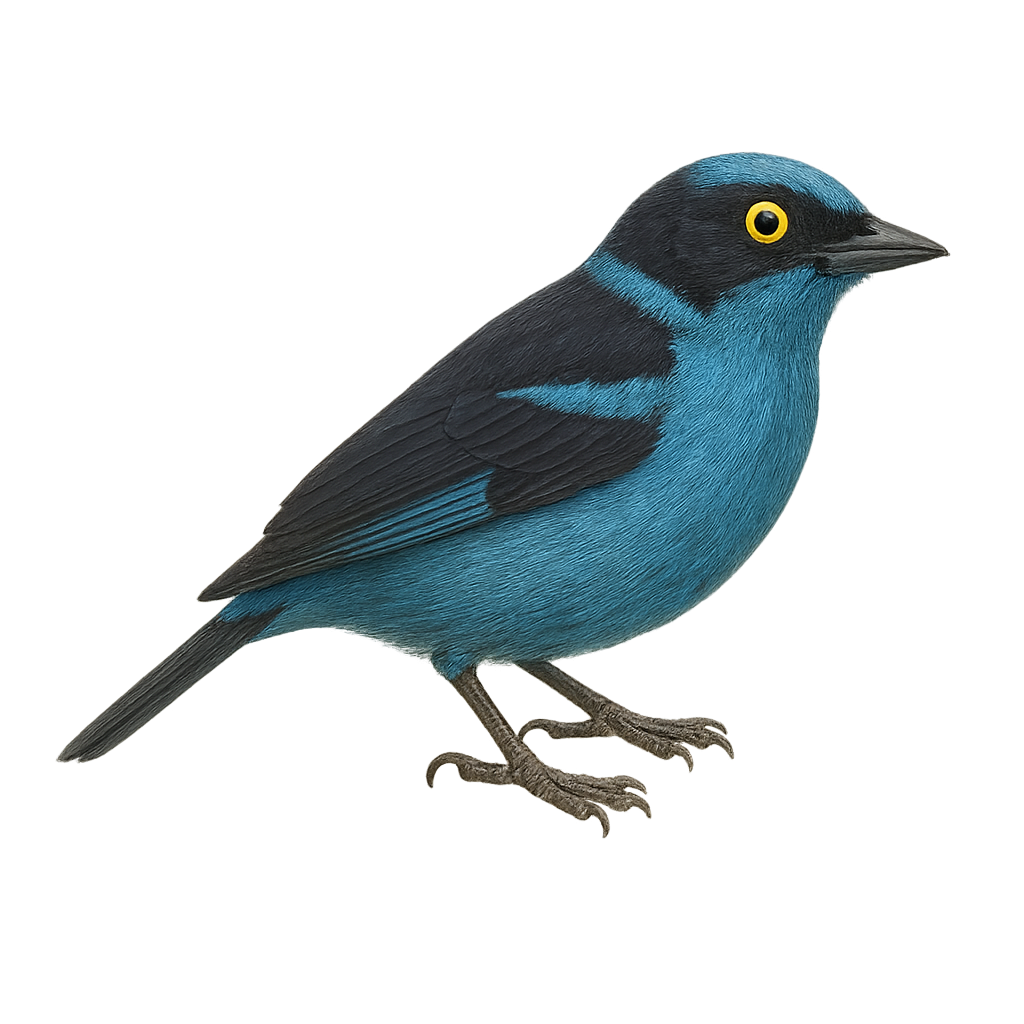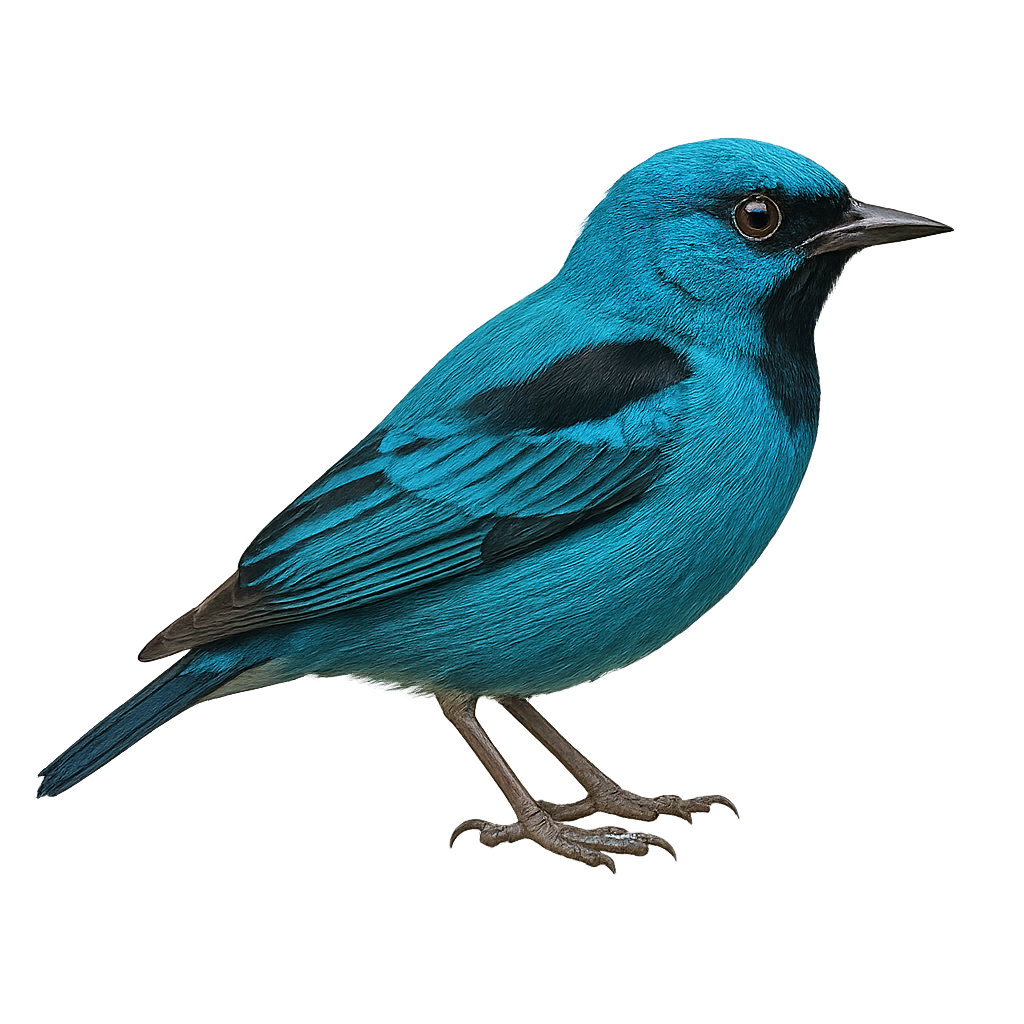The Cavia aperea, commonly known as the Brazilian Guinea Pig, is a small rodent native to South America. Often mistaken for the domestic guinea pig, it is a distinct species. This modest-sized rodent has a stocky body, short ears, and a brownish coat that helps it blend into its natural surroundings. It primarily inhabits grasslands, savannas, and open forests, where it feeds on a variety of vegetation. The Brazilian Guinea Pig is a social animal that lives in groups and communicates through a series of vocalizations. Although mainly diurnal, it can also be active at dusk. Its ability to adapt to various habitats makes it a resilient species.
The Blue-backed Thornbill, or Ramphomicron dorsale, is a small hummingbird endemic to the mountainous regions of South America. It is primarily found in humid forests and shrublands at high altitudes. This hummingbird is distinguished by its striking plumage, with a metallic blue back and white belly. Its slender, slightly curved bill is perfectly adapted for feeding on flower nectar. Males often display brighter colors than females, making them particularly attractive to bird watchers. Despite its small size, this hummingbird is an essential pollinator in its natural habitat, contributing to local biodiversity.
The Blue-throated Mountain-gem, or Lampornis clemenciae, is a captivating bird from the Trochilidae family. This medium-sized hummingbird is notable for its striking blue throat in males, while females have a duller throat. Its plumage is primarily green with metallic sheens, and it has a straight, slender bill adapted for nectar collection. It is mainly found in pine and oak forests, as well as mountainous areas of the southwestern United States and Mexico. Known for its rapid and agile flight, it often produces a distinctive humming sound. This hummingbird plays a crucial role in flower pollination, contributing to the biodiversity of its natural habitat.
The Calothorax pulcher, or beautiful sheartail, is a small hummingbird known for its striking appearance and behavior. This hummingbird is distinguished by its vibrant plumage, featuring metallic green and bright pink hues, especially in males. It is primarily found in the arid and semi-arid regions of Mexico, frequenting scrublands and open forests. This hummingbird is an essential pollinator, feeding on flower nectar with its long, slender beak. It plays a crucial role in the ecosystem by aiding in cross-pollination of plants. Although generally solitary, the beautiful sheartail can be seen in small groups during the breeding season. Its aerial dance is a captivating spectacle, combining agility and speed.
The Broad-billed Hummingbird, Cynanthus latirostris, is a small, vividly colored bird, predominantly green with a bright red bill tipped with black. Native to the arid and semi-arid regions of the southwestern United States and Mexico, this hummingbird is known for its ability to fly backward and hover, allowing it to feed efficiently on flower nectar. It plays a crucial role in plant pollination. Its natural habitat includes oak forests, shrublands, and urban gardens. Despite its small size, it is territorial and can often be seen chasing other hummingbirds away from its territory.
The Bouguer's Hummingbird, or Urochroa bougueri, is a fascinating bird belonging to the Trochilidae family. This hummingbird is distinguished by its dazzling plumage, blending shades of emerald green and metallic blue, with a contrasting white throat. It is primarily observed in the humid forests and wooded areas of the Andes, at altitudes ranging from 1200 to 2400 meters. This hummingbird is an important pollinator, feeding mainly on nectar, but it also consumes small insects to supplement its diet. Despite its small size, it is known for its territorial behavior, vigorously defending its food sources. Its breeding period generally extends from January to May, with egg incubation lasting about 16 to 19 days.
The Black Inca, or Coeligena prunellei, is a hummingbird species endemic to the high-altitude humid forests of Colombia. It is characterized by its glossy black plumage with metallic sheen and a distinctive white patch on its chest. This hummingbird primarily feeds on nectar, using its long slender bill to hover from flower to flower, playing a vital role in plant pollination. Unfortunately, deforestation threatens its natural habitat, leading to a decline in its population. Conservation efforts are crucial to ensure its long-term survival.
The Bahama Woodstar, scientifically known as Nesophlox evelynae, is a small bird endemic to the Bahamas. This hummingbird is notable for its diminutive size and vibrant plumage, featuring shades of green and pink. Males display an iridescent throat that shimmers in the sunlight, while females have more subdued hues. They primarily feed on nectar but also catch small insects to supplement their diet. These birds are often seen in gardens, forests, and mangroves, where they play a crucial role in pollinating local plants. Their fast and agile flight allows them to easily evade predators.
The Buff-tailed Coronet is a medium-sized hummingbird found primarily in the humid forests of the Andes, between 1500 and 2800 meters in altitude. Its plumage is mainly green with a distinctive yellow belly, making it easily identifiable. Known for its speed and agility in flight, it feeds mainly on nectar, which it collects with its long, slender beak. This hummingbird plays a crucial role in the pollination of Andean plants. It is often observed alone or in small groups, and although territorial, it can share its space with other hummingbird species.
The Blue-tailed Emerald, or Chlorostilbon mellisugus, is a small bird with vibrant, metallic green plumage and a distinctive bluish tail. It has a slender, slightly curved bill, perfect for feeding on flower nectar. This hummingbird is widespread in South America, inhabiting various environments from tropical forests to urban gardens. Known for its rapid and agile flight, it often produces characteristic buzzing sounds. Males are particularly territorial, vigorously defending their feeding areas. The breeding season varies by region, but nests are typically constructed with plant materials and spider webs.
The Black-throated Bobwhite is a medium-sized bird belonging to the Odontophoridae family. It is primarily found in the Yucatán region of Mexico, as well as in Belize and Guatemala. This bird is distinguished by its characteristic black throat, contrasting with its brown and white plumage. Males and females exhibit sexual dimorphism, with males having a more pronounced black throat. They typically live in groups and prefer open habitats such as grasslands and savannas. Their diet mainly consists of seeds, insects, and small fruits. Although relatively discreet, they can be heard thanks to their distinctive call, especially during the breeding season.
The Philortyx fasciatus, commonly known as the banded quail, is a bird species belonging to the Odontophoridae family. It is primarily found in the dry and semi-arid regions of Mexico, inhabiting oak forests, scrublands, and open grasslands. This medium-sized bird, measuring approximately 22 to 25 cm in length, is distinguished by its brown plumage with white and black bands on its belly, providing excellent camouflage in its natural habitat. The banded quail is a social bird, often seen in small groups. It primarily feeds on seeds, insects, and small invertebrates. Although it is relatively common within its range, habitat degradation poses a potential threat to its population.
The Blue-backed Conebill is a small bird native to the Andes, easily identified by its bright blue back and distinctive rufous belly. It measures about 12 cm in length and weighs between 10 and 15 grams. Its conical bill is well-suited for its diet, which mainly consists of insects and nectar. This bird is commonly found in humid forests and shrublands at high altitudes. Known for its melodious song and social behavior, it is often seen in small flocks. Although its habitat is threatened by deforestation, it is currently listed as Least Concern by the IUCN.
The Black-cheeked Gnateater is a small bird in the Conopophagidae family, primarily found in the humid tropical forests of South America. It is recognizable by its brown and black plumage, with distinctive markings around the eyes that resemble ears, hence its name. This discreet bird prefers dense undergrowth where it primarily feeds on insects. Its modest size and discreet behavior make it difficult to observe. It is often heard before being seen, thanks to its characteristic song. Although not currently threatened, deforestation poses a potential threat to its natural habitat.
The Burrowing Parrot, Cyanoliseus patagonus, is a medium-sized parrot native to the arid regions of Argentina and Chile. It is distinguished by its predominantly olive-green plumage, with shades of yellow and blue on the wings and head. Its belly features a characteristic reddish hue. These birds live in colonies and are known for digging burrows in cliffs for nesting. Their diet mainly consists of seeds, fruits, and flowers. Although they are sociable among themselves, they can be wary of humans. Their population is stable, but some subpopulations are threatened by habitat loss and illegal capture.
The Ocreatus underwoodii, known as the Booted Racket-tail, is a small hummingbird with a unique appearance. This bird is distinguished by its long racket-shaped tail feathers, giving it a graceful look in flight. Males display bright emerald green plumage, while females are more subdued with softer hues. It is primarily found in the humid forests and forest edges of the Andes, where it feeds mainly on flower nectar and small insects. Its fast and agile flight allows it to move easily between flowers. Although its habitat is threatened by deforestation, it remains relatively common in some areas.
The Black-bellied Thorntail is a small hummingbird native to South America, primarily found in the humid tropical forests of Brazil and Peru. This tiny bird, measuring about 10 cm in length, is easily recognizable by its long, slender tail and iridescent plumage. Males display an emerald green throat and a black belly, while females have more subdued colors. The thorntail feeds mainly on nectar, which it collects while hovering from flower to flower, but it also consumes small insects to supplement its diet. Its rapid and agile flight allows it to navigate through dense vegetation with ease.
The Brandt's Cormorant, or Urile penicillatus, is a medium-sized seabird known for its glossy black plumage and distinctive white plumes on its head during the breeding season. It primarily inhabits the rocky coasts of the North Pacific, from Alaska to Mexico. This cormorant is an adept diver, feeding mainly on fish and crustaceans caught underwater. During the breeding season, it forms dense colonies on cliffs, building nests with seaweed and other marine materials. Although generally silent, it can produce guttural grunts. The Brandt's Cormorant is an important indicator of the health of coastal marine ecosystems.
The Black-faced Cormorant, Phalacrocorax fuscescens, is a medium-sized aquatic bird primarily found along the southern coasts of Australia. It is distinguished by its striking black and white plumage, with a characteristic black face. Its long, hooked bill is well-suited for fishing. This bird is often seen diving to catch fish and crustaceans. It nests in colonies on rocky islands, building nests with seaweed and twigs. The Black-faced Cormorant is an excellent swimmer, using its webbed feet to propel itself underwater. Although mainly coastal, it can occasionally be spotted in estuaries and lagoons.
The Bank Cormorant, or Phalacrocorax neglectus, is a medium-to-large, stocky marine cormorant, endemic to the kelp forests of the Benguela Current along the coasts of Namibia and South Africa. A rare and elusive resident, it is slightly larger and thicker-necked than the Cape Cormorant. Adults show a black throat patch (not orange) and honey-brown eyes, giving them a plain facial appearance. The head is rather flat with a low crest that may appear as a bulbous forehead. In flight, it resembles the Cape Cormorant unless the characteristic white back—seen mostly during breeding—is visible. Immatures are duller but retain the adult’s typical shape. Best observed at roosting sites.
The Barred Fruiteater, or Pipreola arcuata, is a captivating bird found in the humid forests of the Andes. It is distinguished by its bright green plumage and vivid yellow belly, contrasting with dark bars on its chest. This elusive bird is often hard to spot, blending into the dense foliage. It primarily feeds on fruits, playing a crucial role in seed dispersal in its habitat. Its presence is an indicator of the health of Andean forests. The Barred Fruiteater is a solitary bird but can sometimes be seen in small groups. Its call is a soft whistle, often heard before it is seen.
The Blue Coua is an endemic bird of Madagascar, belonging to the Cuculidae family. It is distinguished by its striking blue plumage and medium size, measuring about 48 to 50 cm in length. This bird is primarily arboreal, moving nimbly through the island's tropical rainforests. It feeds mainly on insects, fruits, and small invertebrates. The Blue Coua is known for its melodious song and varied calls, often heard at dawn and dusk. Although its habitat is threatened by deforestation, it is currently classified as "least concern" by the IUCN.
The Bengal Coucal, or Centropus bengalensis, is a fascinating bird belonging to the Cuculidae family. It is primarily found in the humid and marshy regions of South and Southeast Asia. This bird is distinguished by its dark brown plumage and rufous wings, which contrast with its black head and tail. The coucal is a medium-sized bird, measuring about 40 to 50 cm in length. It is known for its discreet behavior and ability to move silently through dense undergrowth. The Bengal Coucal is an opportunistic predator, feeding on insects, small reptiles, and sometimes small mammals. Although it is mainly terrestrial, it can fly short distances.
The Burchell's Courser, scientifically known as Cursorius rufus, is an elegant terrestrial bird primarily found in the arid and semi-arid regions of southern Africa. Its plumage is dominated by shades of beige and brown, allowing it to blend seamlessly into its sandy environment. The wings feature distinctive black and white markings visible in flight. This bird is known for its long legs and slender bill, adapted to its ground-dwelling lifestyle. It primarily feeds on insects and other small invertebrates, which it captures by running swiftly on the ground. The Burchell's Courser is a diurnal bird, often seen alone or in small groups. Its ability to camouflage and discreet behavior make it sometimes difficult to spot.
The Black-backed Puffback, or Dryoscopus cubla, is a medium-sized bird belonging to the Malaconotidae family. It is primarily found in wooded areas and savannas of sub-Saharan Africa. This bird is distinguished by its black and white plumage, with a black back and white belly, hence its name. Males and females show slight sexual dimorphism, with males having brighter colors. Known for its melodious and varied song, it is often heard before being seen. The Black-backed Puffback is a territorial bird, usually living in pairs or small family groups. It primarily feeds on insects but can also consume fruits and seeds.
The Black-necked Swan, Cygnus melancoryphus, is a graceful waterbird native to South America. It is easily recognized by its pure white plumage contrasted with a black neck and a striking red knob at the base of its bill. Preferring freshwater lakes, lagoons, and marshes, it primarily feeds on aquatic plants. Known for its elegance, it swims gracefully and often forms monogamous pairs that share parental duties. While generally tolerant of humans, it can become wary if threatened. Its population is stable, but it remains vulnerable to environmental changes.
The black swan, Cygnus atratus, is a large waterbird native to Australia, easily identifiable by its black plumage and bright red bill. Measuring up to 1.4 meters in length with a wingspan reaching 2 meters, it is one of the largest swans. Black swans primarily inhabit lakes, rivers, and marshes, feeding on aquatic plants. They are known for their social behavior and often form groups. Nesting usually occurs on isolated islands or shores. Although mostly sedentary, some may migrate depending on climatic conditions.
The Blue Dacnis is a small, colorful bird native to the tropical forests of South America. It is easily identified by its striking plumage: males have a bright blue head and back, while females display greener hues. This passerine measures about 12 cm in length and primarily feeds on fruits, nectar, and insects. It is often seen in small groups or pairs, actively moving through the canopy in search of food. Although its habitat is threatened by deforestation, the Blue Dacnis remains relatively common within its range.
The Blue Dacnis, or Dacnis cayana, is a small, colorful bird found in the tropical forests of South America. Males display vibrant blue plumage with black wings and tail, while females are a more subdued green. Measuring about 12 to 13 cm, this bird is often seen in pairs or small groups. It primarily feeds on fruits, nectar, and insects, playing a role in pollination and seed dispersal. The Blue Dacnis is a diurnal bird, most active in the morning and late afternoon. It is known for its melodious song and aerial acrobatics when feeding in the canopy.
The White-fronted Damalisque is a medium-sized antelope, recognizable by its reddish-brown coat and the distinctive white band that crosses its forehead, which gives it its name. It stands between 1.30 and 1.50 meters tall at the withers and weighs between 50 and 70 kg. This mammal primarily inhabits open savannas, grasslands, and semi-desert areas, preferring open terrain where it can graze on grasses, leaves, and stems. It is well adapted to heat and drought, thanks to its short coat and behavior of seeking shade during the hottest parts of the day. The White-fronted Damalisque lives in small groups, often consisting of females and young, while adult males usually live alone or in small groups. It is mainly active in the morning and late afternoon, when it is easier to feed while avoiding the heat of the day. While the species is currently in good health, it faces threats such as illegal hunting, habitat loss due to human expansion, and competition with livestock for food resources.


